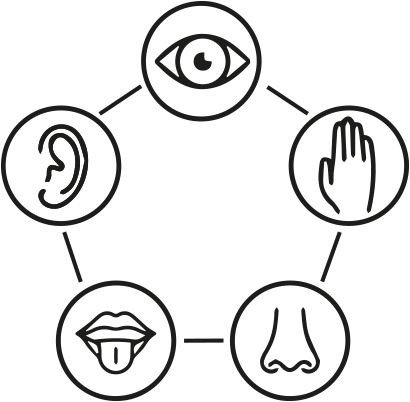EarPhones by Kaspar König
Kaspar König is a transdisciplinary artist resident in Zürich. He is working on an acoustic headphone used for contemplation and movement exercises. He is a part of an upcoming SBL publication.
edUMinded – “PBL otherwise: senses-based learning"
https://www.maastrichtuniversity.nl/news/edlab/eduminded/pbl-otherwise-senses-based-learning
UMConnect – “More than meets the eyes"
The Observant - “The more senses you use, the more you learn”
Marres
https://marres.org/en/home-en/
Marres develops exhibitions, organizes workshops, issues unique publications, creates walks in the city and region and offers a wide range of education and participation activities. Marres’ program focuses on experience and emphasizes on the working of the senses and the language of the body.
Journal of sensory studies
https://onlinelibrary.wiley.com/journal/1745459x
The Journal of Sensory Studies is a peer-reviewed scientific journal that covers research on "human reactions to basic tastes on foods, beverages, wine, liquor/beer, the environment, medications, and other human exposures in every day life"
The Sensory Cities THiNK-KiT
http://sensorythinktank.com
The Sensory Cities THiNK-KiT makes a case for the importance of interdisciplinary and cross-professional investigation of urban sensing. It brings together methods and resources for researching, designing, curating and representing the senses in the city, drawing on the reflections of an Arts and Humanities Research Council UK funded “Sensory Cities” international research network, which involved academics, artists and urban professionals across Europe to discuss and exchange methodological approaches.
Centre for sensory studies
https://centreforsensorystudies.org/centre-for-sensory-studies/
The Centre for Sensory Studies is an interdisciplinary collaboration platform for research in the social life and history of the senses, multisensory aesthetics, sensory design and marketing, and the development of technologies for expanding the sensorium in innovative ways. It is based in Canada.
Sensory Studies
https://www.sensorystudies.org
Sensory studies arises at the conjuncture (and within) the fields of anthropology • sociology • history • archeology • geography • communications • religion • philosophy • literature • art history • museology • film • mixed media • performance • phenomenology • disability • aesthetics • architecture • urbanism • design
Sensory Studies can also be divided along sensory lines into, for example, visual culture, auditory culture (or sound studies), smell culture, taste culture and the culture of touch, not to mention the sixth sense (however it might be defined)
Sensory Maps
https://sensorymaps.com
Dr Kate McLean works at the intersection of human-perceived smellscapes, cartography and the communication of ‘eye-invisible’ sensed data. To achieve this, she leads international public smellwalks and translates the resulting data using digital design, watercolour, animation, scent diffusion and sculpture into smellscape mappings.
SenseSquared
https://sensesquared.eu/
Six European partners work together on the central question: How can a sensory approach and an artistic attitude contribute to an education that leads to a more connected and sustainable world?
Sensing Spaces of Healthcare
This network explores opportunities for collaborative thinking, making, research and funding in the sensory history of healthcare environments.
Sensuous Ethnographies Incubator
https://imaginative-ethnography.com/sei/
The Sensuous Ethnographies Incubator is a loose and improvisational research cluster of artist-scholars that draws on methods of sensory and imaginative ethnography to think through questions of being and knowing and sensing in place.
Mediamatic
Mediamatic is sinds 1983 een instelling gericht op nieuwe ontwikkelingen in kunst en cultuur. We houden ons bezig met natuur, biotechnologie en -kunst. We organiseren lezingen, workshops en kunstprojecten in een sterk internationaal netwerk.
Art space that experiments with different types of exhibition design, including sensory design.
The Dutch Institute of Food & Design
https://thedifd.com
The Dutch Institute of Food & Design creates a global platform for designers working with food and eating. We explore how we create food and what, why and how we eat. We show the relevance of food connected to design and design connected to food. We ask critical questions about the discipline and link designers to each other and other sectors. The DIFD brings an emerging design discipline to the next level. With our final goal in mind: to enrich eating cultures and address the societal and environmental challenges around food using design as a tool to achieve this.
The Netherlands Olfactory Science Exchange
https://www.nosenetwork.nl
The Netherlands Olfactory Science Exchange is a multi-disciplinary enterprise that brings together researchers, experts, artists, and organisations in the field of odour and flavour perception and cognition. Its initiation was stimulated by The Netherlands Organisation for Scientific Research (NWO) grant ‘Human olfaction at the intersection of language, culture and biology’.
Odeuropa Network
https://odeuropa.eu/network/
Big network of people who work with the senses (smell related mostly); possible format for our network page for website - they also provide an online registration form for new people coming to the website who want to be put on the network. The organization itself is led by Caro Verbeek & does workshops, events & exhibitions that involve the sense of smell.
WalkingLab
https://walkinglab.org
WalkingLab is a SSHRC-funded international research-creation project co-directed by Stephanie Springgay (McMaster University) and Sarah E. Truman (University of Melbourne). WalkingLab studies and advances the theory and practice of critical walking methodologies through interdisciplinary arts practices and public walking events. The various projects and events activated at WalkingLab draw on feminist-queer, anti-racist, anti-ableist, and anti-colonial thought and practice to question who gets to walk where, how we walk, under whose terms, and what kind of publics we can make.
